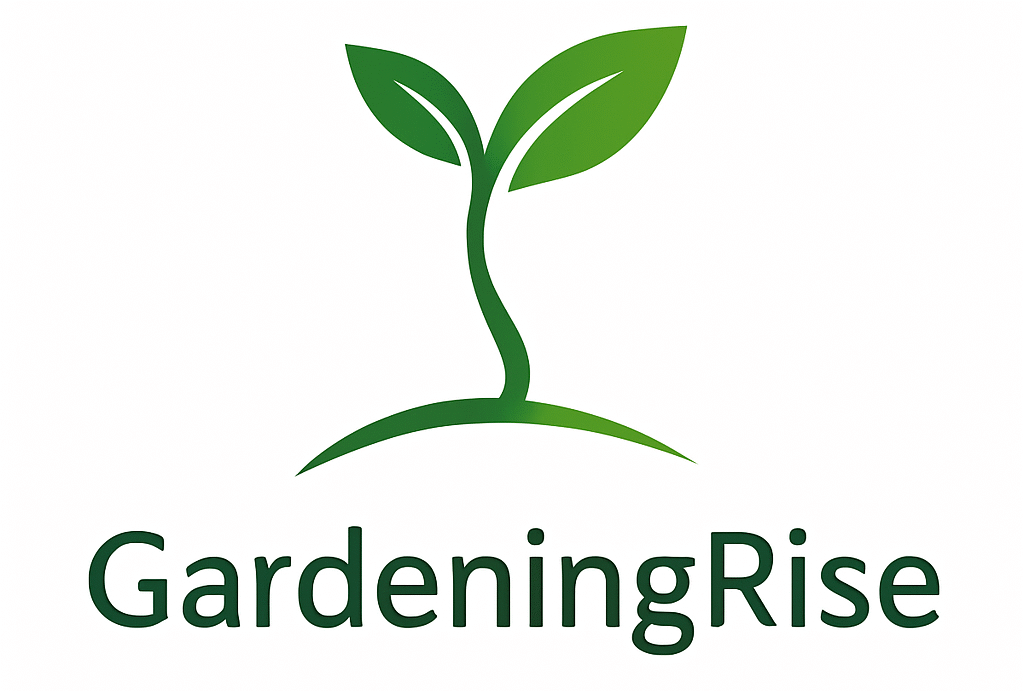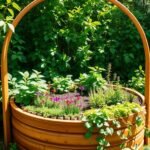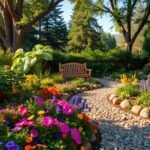Imagine tending to vibrant flowers or fresh vegetables without straining your back or knees. Elevated planting systems are changing how people interact with their green spaces, offering ergonomic design that adapts to your needs. These structures bring your plants closer to eye level, creating a welcoming environment for gardeners of all physical abilities.
Traditional methods often require constant bending, which can deter many from enjoying this fulfilling hobby. Modern solutions tackle this challenge head-on by providing waist-high access to soil and crops. You’ll spend less time crouching and more time nurturing your favorite blooms or herbs.
What makes these setups stand out? They give you complete command over soil quality and moisture levels. Loose, nutrient-rich earth promotes stronger root growth while preventing waterlogging. This precision helps plants thrive, whether you’re growing juicy tomatoes or fragrant lavender.
Urban dwellers and suburban homeowners alike appreciate how these systems maximize limited areas. You can transform patios, balconies, or small yards into productive green zones. Even better—they naturally discourage unwanted visitors like slugs or rabbits from feasting on your hard work.
This approach isn’t just about practicality—it’s about creating joyful experiences. Families bond over tending shared plots, while individuals find peace in daily plant care routines. Ready to discover how these innovations can reshape your connection with nature?
Exploring High Raised Garden Beds: Convenience, Accessibility, and Pest Defense

Elevated planting systems simplify growing while boosting results. They let you skip the backaches of traditional gardening by bringing your plants to waist height. You’ll notice fewer weeds and better yields thanks to their contained design.
Key Advantages for Every Gardener
These systems give you full control over soil quality. Mix compost, sand, or organic matter to create ideal conditions for your crops. Unlike ground plots, they prevent soil compaction, letting roots spread freely.
Watering becomes smarter, too. Excess moisture drains quickly, reducing root rot risks. You’ll save time by targeting irrigation directly to plant roots instead of wasting resources.
| Feature | Traditional Gardens | Raised Systems |
|---|---|---|
| Soil Control | Limited | Customizable |
| Weed Growth | Common | Reduced by 60%* |
| Harvest Yield | Variable | Up to 30% higher |
What Makes These Systems a Game-Changer?
Small spaces flourish with vertical growing options. Train cucumbers up trellises or stack strawberry planters to multiply your harvest. You can even extend seasons using simple covers for frost protection.
Pests? Not here. The elevated height deters ground critters, while mesh barriers keep flying insects away. Your kale and zinnias stay safe without harsh chemicals.
Best part? These setups look sharp. Neat wooden frames or sleek metal designs turn functional spaces into eye-catching features. Landlords and neighbors will appreciate the tidy appearance.
Benefits of Elevated Gardening for Improved Mobility and Pest Control

Gardening becomes effortless when your plants meet you at the perfect height. These systems let you nurture greens without kneeling or stretching. They also act as invisible shields against critters that love to munch on your hard work.
Tailoring Heights for Comfortable Planting
For wheelchair users, 24-30 inch structures allow easy reach to soil and plants. Standing gardeners thrive with waist-level setups that reduce bending by 80%. Customizable options let you match the height to your unique needs.
| User Type | Ideal Height | Key Benefit |
|---|---|---|
| Wheelchair Users | 24″-30″ | Arm-level access |
| Standing Gardeners | 32″-36″ | Minimal back strain |
| Children | 18″-24″ | Learning-friendly |
Smart Protection From Ground to Sky
The elevated design naturally blocks slugs and rabbits. Line your step-by-step raised bed construction guide with hardware cloth to stop burrowers like moles. This layered approach keeps roots safe without chemicals.
Weeding becomes simpler too. Contained soil means fewer unwanted plants, and the comfortable height lets you remove invaders while seated. One gardener shared: “I finally enjoy tending my herbs without aching joints!”
Pets and foot traffic won’t crush your crops in these contained spaces. Add removable mesh covers during peak pest seasons for extra protection. Your plants stay healthy while you maintain effortless control.
Choosing the Right Raised Bed Materials and Design

Your garden’s foundation starts with smart material choices that balance beauty and practicality. Let’s explore three popular options that shape your growing experience for years to come.
Comparing Wood, Metal, and Plastic Composite Options
Wooden structures bring natural charm to outdoor spaces. Cedar and redwood stand out for their pest-resistant qualities and warm appearance. However, they need yearly sealing to prevent rot. One gardener notes: “My cedar beds lasted seven seasons with proper care—worth every minute!”
Galvanized steel offers sleek modernity paired with rugged durability. These metal beds withstand harsh winters and humid summers without warping. Their rust-resistant coating ensures your setup remains intact for over a decade.
Plastic composites shine for low-effort maintenance. Lightweight and weatherproof, they come in colors matching your patio furniture. No staining required—just wipe clean each spring.
Balancing Aesthetics, Durability, and Maintenance
Consider these factors when selecting materials:
- Initial cost vs long-term value: Wood costs less upfront but needs regular upkeep
- Climate compatibility: Metal excels in rainy regions, while composites handle temperature swings
- Assembly needs: Plastic kits snap together; wooden beds require basic tools
Your local climate dictates material performance. Coastal areas benefit from corrosion-resistant metals, while arid zones suit untreated woods. Match colors and textures to your home’s exterior for cohesive design that pleases the eye season after season.
Pre-built vs Custom Raised Beds: What Suits Your Garden Best
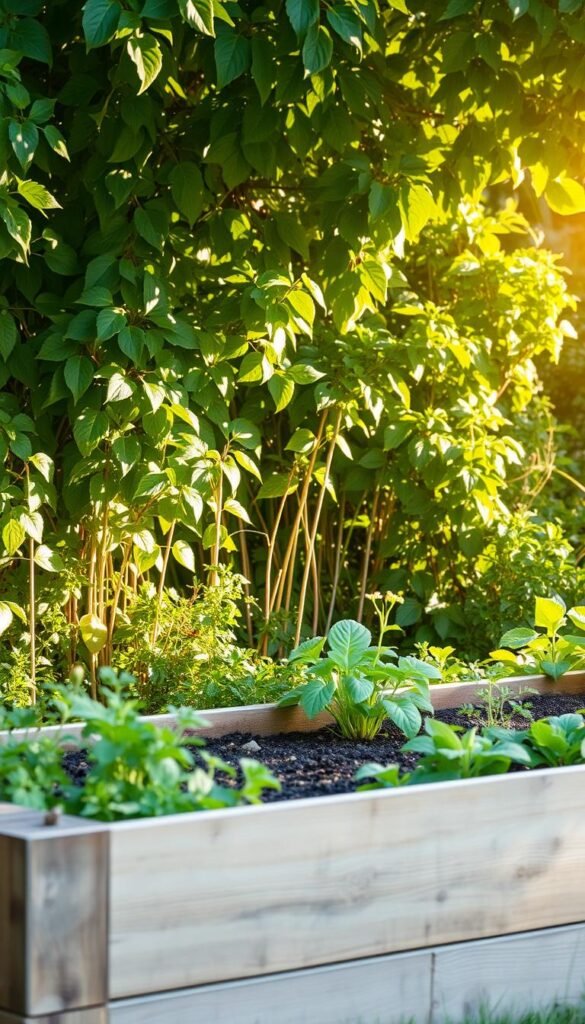
Your green space deserves a setup that matches your lifestyle and available area. Pre-built options let you skip construction stress, while custom designs offer tailored solutions. Let’s explore which approach helps your plants thrive faster.
Ease of Assembly and Immediate Garden Use
Pre-built systems shine for gardeners wanting results right away. Most kits snap together in under an hour—no saws or drills required. One user shared: “I assembled my 4’x8′ bed during lunch and planted herbs before dinner!”
| Feature | Pre-built | Custom |
|---|---|---|
| Assembly Time | 15-60 minutes | 4-8 hours |
| Tools Needed | None | Power tools |
| Planting Start | Same day | Next week |
Matching Bed Size and Shape to Your Available Space
Measure your patio, balcony, or yard before choosing. Compact 2’x4′ beds fit tight corners, while sprawling 8’x4′ rectangles suit open areas. Consider these popular configurations:
| Space Type | Ideal Bed Size | Best For |
|---|---|---|
| Balcony | 18″x36″ | Herbs & flowers |
| Backyard | 4’x8′ | Vegetables |
| Deck | Circular 3′ | Mixed plantings |
You’ll find pre-built types in cedar, metal, and recycled plastics. Custom builds let you create hexagons or tiered shapes for visual interest. Remember: Proper sizing ensures easy access to all plants without overcrowding.
Practical Installation Tips for Maximizing Garden Performance
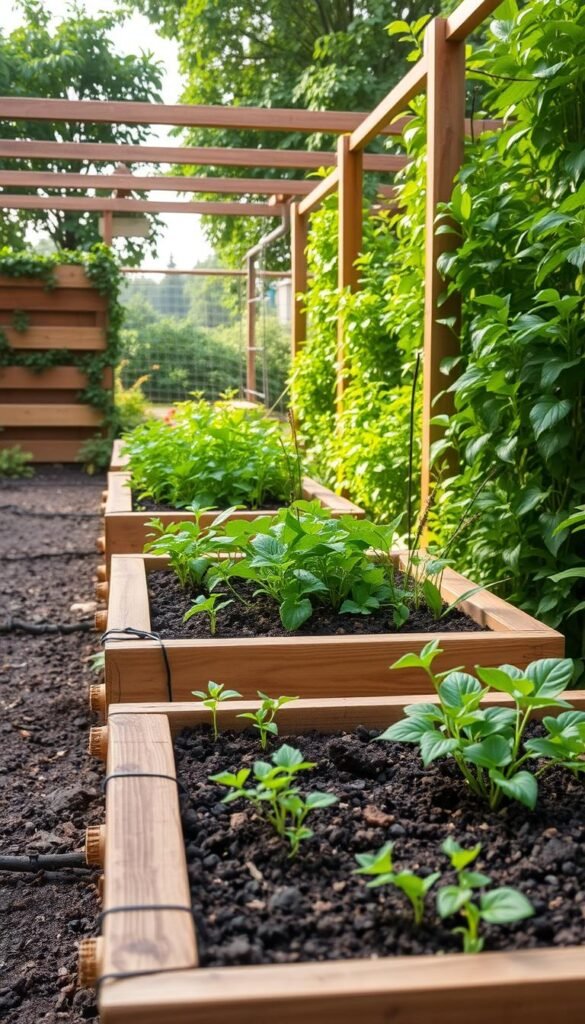
Sunlight fuels your plants’ growth, but smart placement does the heavy lifting. Let’s explore how strategic setup choices boost your growing success while saving effort.
Selecting the Perfect Location with Optimal Sunlight and Drainage
Track sun patterns for 2-3 days before choosing your spot. Most veggies and flowers need 6-8 hours of direct light daily. Leafy greens handle partial shade, but tomatoes and peppers demand prime sunny real estate.
| Plant Type | Sun Needs | Ideal Placement |
|---|---|---|
| Tomatoes | Full sun | South-facing areas |
| Lettuce | Partial shade | East-facing edges |
| Root vegetables | Moderate sun | Morning light zones |
Level the ground using a carpenter’s level—slopes cause uneven water distribution. Position your setup within 10 feet of a hose connection for stress-free irrigation.
Building a Strong Foundation with Weed Barriers and Hardware Cloth
Clear grass and weeds thoroughly before laying materials. Thick cardboard sheets make excellent weed barriers—they decompose while blocking invaders. One gardener reported: “My spinach grew untouched for two seasons after using this method!”
- Cut hardware cloth to fit bed bottoms
- Overlap edges by 3 inches
- Secure with landscape staples
This metal mesh stops gophers and moles from tunneling into your soil. Pair it with gravel layers for enhanced drainage, preventing soggy roots during heavy rains.
Maintenance and Soil Management for a Thriving Garden
Keeping your growing space productive year after year requires smart soil care and timely upkeep. Proper management ensures your plants get the nutrients they need while extending your setup’s lifespan. Let’s dive into methods that keep everything flourishing.
Seasonal Soil Refresh and Composting Strategies
Refresh your soil each spring and fall by mixing in 2-3 inches of compost. This replenishes nitrogen and improves texture. Many gardeners use a classic blend: equal parts compost, peat moss, and vermiculite for optimal drainage.
| Refresh Method | Frequency | Benefits |
|---|---|---|
| Top-dressing | Every season | Quick nutrient boost |
| Full replacement | Every 3-5 years | Resets soil structure |
| Crop rotation | Annually | Prevents disease buildup |
Rotate crops to protect soil health. Follow heavy feeders like tomatoes with nitrogen-fixing peas. One grower shared: “Swapping my bean and pepper locations each year doubled my harvests!”
Protecting Your Raised Bed from Weather and Wear
Inspect wooden frames each spring for cracks or insect damage. Apply a natural sealant like linseed oil to prevent rot. Metal and plastic setups benefit from gentle scrubbing to remove mineral deposits.
Add a gravel layer under your soil mix during installation for better drainage. Use breathable fabric covers in winter to shield plants from frost while letting moisture escape. Pair these steps with smart plant choices—like low-maintenance blooms that thrive in your climate.
Enhanced Strategies for Pest Defense in Raised Bed Gardens
Outsmarting garden invaders requires clever tactics that work smarter, not harder. Elevated growing spaces give you unique advantages for creating fortress-like protection around your plants. Let’s explore how to combine simple tools with smart design for year-round security.
Physical Barriers: Your First Line of Defense
Floating row covers create invisible shields against birds and squirrels. These lightweight fabrics let sunlight through while keeping pests out. One gardener shared: “My broccoli survived three squirrel raids after installing these—they’re worth their weight in gold!”
For underground threats, line your bed bottoms with hardware cloth before adding soil. This metal mesh stops burrowers like voles from reaching plant roots. Pair it with vertical barriers around the perimeter for complete protection.
Smart Mesh Solutions for Airborne Threats
Garden mesh offers superior defense against flying insects compared to ground plots. Its tight weave blocks cabbage moths and cucumber beetles while allowing airflow. Unlike traditional setups, elevated beds make installation effortless—no awkward crouching required.
| Barrier Type | Pests Blocked | Installation Time |
|---|---|---|
| Row Covers | Birds/Squirrels | 5 minutes |
| Hardware Cloth | Moles/Voles | 20 minutes |
| Garden Mesh | Flying Insects | 10 minutes |
The elevated design naturally deters pets and kids from trampling plants. Add a decorative fence for visual appeal while keeping curious paws at bay. Those transitioning from traditional rows often find pest management becomes 40% easier with these setups.
Rotate barrier types through seasons for maximum impact. Combine mesh covers with companion planting for a chemical-free approach that keeps your harvest safe and sustainable.
Designing Your Raised Bed Garden for Maximum Yield and Beauty
Transform your growing space into a lush paradise that feeds both body and soul. Strategic design choices let you grow more in less area while creating visual harmony. Let’s explore how smart layouts and vertical tricks turn functional plots into living masterpieces.
Sky-High Harvests with Vertical Innovation
Train climbing vegetables like beans upward using trellises or arches. This frees ground space for leafy greens beneath. Try pairing pea vines with shade-tolerant lettuce—you’ll harvest two crops from one footprint.
Add edible borders for flair and function. Radishes grow quickly along bed edges, while nasturtiums spill over sides with vibrant blooms. These flowers pull double duty: attracting pollinators and spicing up salads.
Layout Secrets for Effortless Care
Group plants by water needs to simplify irrigation. Place thirsty tomatoes near your square-foot gardening layout’s center, with drought-tolerant herbs along the edges. Leave 18-inch paths between beds for comfortable kneeling or wheelchair access.
Mix textures and colors for eye-catching displays. Purple basil beside golden marigolds creates contrast while repelling pests. Remember: beauty boosts productivity—happy gardeners tend their plots more often!
